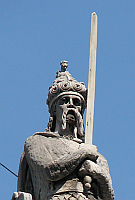
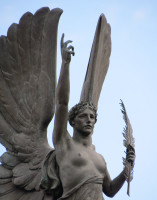
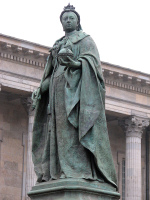
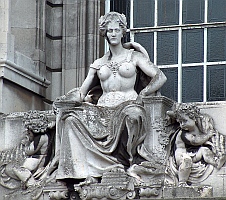
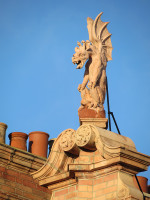
Victorian and Edwardian sculptors are, by and large, much less familiar to us than Victorian painters, or even illustrators. A moment’s thought suggests several reasons – from the fact that Victorian graphic imagery is still used very widely, for example on book covers and ornamental wares, unlike sculpture, to recalling that sculpture includes a high proportion of portraits, where we tend to concentrate on who is being shown and how much they look as they ought, to the exclusion of who made the artwork. Having said that, the most well-known sculptures are iconic and familiar – for example Nelson on his column and the lions below in Trafalgar Square, and the Eros in Piccadilly, London.
Where to start with sculpture then? A word on dates - Queen Victoria of course ruled from 1837-1901, and King Edward VII from 1901-1910, but a sculptor who was at his peak in early Victorian times would have had his early career before then, and the Edwardian sculptors were still in the ascendant in the making of most of the many memorials to World War I, We therefore have our date range fairly elastic and fuzzy at the beginning (1830s and a bit before) and the end (1910s and just into the 1920s). It is convenient to divide our sculpture into several groups, the examples below having something of a bias towards Victorian rather than Edwardian examples, and the focus being very much on figure sculpture and animal sculpture. As ever, click to enlarge the pictures.
The first group has to be portraits –commemorative portrait statues and busts and high relief plaques in public spaces - see the list of places on the sculpture pages for London and for other places – and their counterparts indoors in museums and great houses, and in cathedrals and churches in more mournful setting – see the links to City Churches and other London Churches. Though the most widespread and familiar type of victorian sculpture, portraits can be hard to get to grips with – either you are interested in the actual person depicted, or they can tend to be rather easy to dismiss.
What should we look for in a portrait sculpture? Apart from a good likeness if we are familiar with the individual, we want characterfulness in the face, and the hands. As with any portrait, character tends to be revealed more satisfyingly with the increasing age of the sitter. Portrait statues often have accoutrements relevant to the deeds of the subject, or he (less often she, unless a Queen, until the later 20th Century) is depicted at some key moment in their life. The plinth on which the statue stands may have further sculpture in the form of plaques showing important incidents from the subject’s career, or allegorical free-standing sculptural groups. Regarding clothing, earlier statues tend to follow the example of Roman civic statues, and wear cloaks or togas or occasionally armour; from around the 1840s there is a switch to contemporary clothes, though a heavy cloak is often to impart the dignity of Roman costume. Portraits of familiar figures may also be a feature of architectural sculpture, on the fronts of buildings – poets and writers for libraries, local statesmen and clergy for town halls, the reigning monarch perhaps, and so on. Examples in London include the series of two-dozen artists, architects and craftsmen on the front of the V&A, the various statesmen on the Foreign and Colonial Office in Whitehall (see this page), and the 169 great men on the Albert Memorial frieze. Further afield, we may mention Bradford City Hall as having a complete set of statues of Kings and Queens from William the Conqueror right through to Queen Victoria. The great industrial cities of the Midlands and the North consciously put up lots of statues of their politicians, thinkers, inventors and industrialists: see for example sections of this site on Leeds, Liverpool and Manchester.
In terms of prestige, a bronze public statue was better than a stone one, and for monarchs and military men, if not politicians, grandest of all would be a bronze portrait statue on a horse - the equestrian portrait statue. There are one or two Victorian or Edwardian equestrian statues in most cities, and rather a lot in London, of which some are pictured in detail on this page and on this page; others are scattered across this website.
Victorian equestrian portrait statues.
Of course portraiture was where the commissions tended to come from, and what many sculptors had to do for most of their time, but I think that they tended to feel the restriction of being tied to portraiture – perhaps this is why statues of great men sometimes manage the introduction of an ideal girl or two, to liven up an otherwise unremarkable standing chap holding a book or scroll. This brings us to our second group – the ideal figure. This is much more interesting, and more likely to catch the imagination of those who enjoy the work of the Pre-Raphaelites and their allies in painting. Such statues are most common in the galleries rather than outdoors. Tombs and monuments in churches and cemeteries also offer good opportunity for ideal and allegorical mourners, and decorative statues may also be found in gardens and town squares.
Looking at an allegorical or ideal work, we want first to work out who is being shown – difficult if faced by an unclad figure – the nude is much more central to sculpture than painting, and a figure of Hope might be indistinguishable from a Truth or an Echo, an Atalanta, a Venus or just a nymph without some label. However, in many cases we can of course work out who we are looking at because the figure is holding or wearing or accompanied by something pertinent (e.g. Diana with her bow and dog - see this page and this page, Justice blindfolded or bearing scales or a sword - see this page), or doing something characteristic (e.g. Courage killing some serpent or beast). In some cases this may be taken to extremes, with a figure surrounded by heaps of accoutrements, with extra things on the base of the statue by the figure’s feet. Many allegorical figures are shown and discussed on these pages, starting from the Allegorical Alphabet page.
Much more than the portrait statue, which tends to be of simple composition and designed to be looked at from the front or in noble profile, ideal and allegorical works may have compositions which need to be seen from more than one vantage point, or have narrative content which can only be appreciated by walking around the statue. This is especially true of more complicated groups, which may be baroque in their intricacy. The sculptor often has an eye too for the silhouette of the work, if it is to be seen against the sky, or along a road – all assuming that the position was anticipated, and the work has not been moved or its surroundings changed.
As noted above, statues in churches and cemeteries are relevant in this context, for the many angels and typical mourning females – wives, daughters, figures of Faith, or Hope and Charity, or typically aged men as Time and Death, and so on. This note largely avoids chronology, but it is particularly relevant here – works of earlier times than Victorian can give much more variety in figures of Death, demons etc (see for example the page on skulls in sculpture). Eighteenth and early Nineteenth century figure sculpture tends to be very classical, with the girls having characteristic round faces, and conventional poses, often lounging nonchalantly against a tomb, leaning on an elbow, legs comfortably crossed, or staring melodramatically skywards. Victorian figures, especially later in the period, are much more striking and sympathetic, and there are a number of very intense examples from Art Nouveau and Edwardian times. A difference from secular allegorical sculpture is that there is almost no opportunity for the nude, as this was considered not the done thing in a ecclesiastical or mourning setting, but this is to some extent circumvented by many sculptors through the use of the semi-draped statue, and the use of very light drapes that serve to emphasise rather than conceal the figure. It should be said that although Victorian cemeteries are clustered with figure sculpture, already by the beginning of the Victorian period, church monuments were becoming plainer in the main, and with some very notable exceptions, much of the best statuary in churches is from earlier times. See the Introduction to smaller Church monuments, and Monuments in Churchyards page.
Ideal figure sculpture inside and outside the church.
We may separate out War Memorials as a further group. In some cases what we see is simply further examples of allegorical figure sculpture; others include soldiers in characteristic uniform. The Boer War gave rise to some of the best war memorial sculpture, just after the Victorian period of course but generally by the same Victorian sculptors, and the First World War memorials were often the work of older Victorian and Edwardian artists rather than those of a new generation of sculptors, so show a continuation of the Art Nouveau ideal well into the 20th Century. The detail of military uniform can convey much about a statue, I am told, but I have no knowledge of military uniform, and these pages have almost nothing to comment on the subject, tending to concentrate on the examples with allegorical figures, angels and so forth.
A fourth group is architectural sculpture – strictly not simply a statue stuck on the top of a building, but something more integral by way of surface decoration, often in high relief rather than in the round, which enhances and complements the architecture. Again, very much of interest to these pages, and tending greatly to the allegorical figure, the descriptive panel and the ornamental. Indeed, for these pages, architectural interest is largely confined to the surface decoration. All of the walks round towns linked to through the London page and Other England page focus on architectural sculpture. The allegorical figure on a building tends to be different to that which is free-standing – a different range of allegory, with less of the emotions and character traits (Love, Peace, Death) and more of suitably civic figures, such as Justice, Education, Government, and Commerce. Because there is a background and surround to the figure, there is much more opportunity to show their accoutrements, or a scene or narrative story across the piece. Conversely, unlike free-standing works, architectural sculpture is generally designed to be seen from only one viewpoint, straight in front, and often from a distance below. It is fair to say that much architectural sculpture was conceived without much appreciation of the scale of the building it was to decorate, or its setting, or the setting has since changed, so the sculpture may appear disproportionate (typically the sculpture looks too small and fiddly rather than too large) or simply impossible to see properly because it is too high up and can only be seen at too oblique an angle. But though an architect might disagree, this should not stop Victorians such as ourselves appreciating the sculpture for its own sake. I have included some rather detailed walks down some London streets to look at the smaller decorative features as well as the larger ones: see the pages on Regent Street, Oxford Street West and Oxford Street East, Tottenham Court Road and Charing Cross Road, Fleet Street and the Strand. If you are interested in the particular types of sculpture on buildings, see the pages on pediment sculpture, niche sculpture, spandrel sculpture, caryatid sculpture and so forth, all accessible from the architecture page on this site.
We have already noted the not uncommon portraits on buildings – the library with its Shakespeare and Chaucer, the civic building with small bust of the monarch and their spouse. And churches and cathedrals were richly decorated in Victorian times with their principal saints, bishops and other clergy – some holding miniature copies of their building. But rather more commonly, portrait busts on buildings are typical rather than specific – for example a trading company’s building might include typecast portraits of people of other cultures. Most ubiquitous of all are heads on the keystones of first floor windows, or rows of smaller heads acting as bosses along a string course. These are typically ideal and classical on baroque buildings, indeterminate bearded heads made of Coade stone on older terraced residences (though Coade works would be too early for Victorian), and many examples of richly bearded Neptunelike heads wherever a nautical linkage can be implied, however tenuous. See the Introduction to Keystone sculpture, and the Female Keystone Heads page, the Keystone Bearded Heads page, and for a nice example on a single building, the Manchester Bridge Street page.
Architectural sculpture: keystone heads.
A further group, rather small, is animal sculpture (not counting horses). A few sculptors specialised in this genre – J. M. Swan is one; other sculptors were happy to introduce the odd animal where appropriate, particularly in the allegorical frieze. Lions are common – Landseer’s ones in Trafalgar square were the only important venture into sculpture by this famous animal painter; Alfred Stevens did the little ones reproduced on the railings of the British Museum; Keyworth was the sculptor of the big ones for Leeds Town Hall and Simonds a huge one for Reading – see this page for lions, and this one for lion heads. The Albert Memorial has the Continents groups with a camel, elephant, bull and so forth. More exotic, for instance, is a discreet hippo on the front of the Foreign Office (see the Whitehall page), and a variety of half-human half-animal classical gods may be found for example on the base of the Victoria Memorial in front of Buckingham Palace. Oddly, only a few sculptured animals are in London Zoo and less from Victorian times. Some good extinct ones, akin to gargoyles, are on the front of Waterhouse’s Natural History Museum, and the interior, where not covered by modern displays, has beautiful sculpture of extinct and living lifeforms on the pillars and walls. We should also mention the dinosaurs and later animals in their lake in Crystal Palace park in this context. And for a sculptor minded to do so, any fountain is excuse enough for some marine life – a good example being the fountain in front of the Victoria Rooms, Bristol, which has not just fish but also an octopus, starfish, turtle, and seasnails. A variety of animal sculpture can be accessed from this page.
Sculptures of mythical beasts and part-human part-animal statues, are an important part of Victorian and Edwardian sculpture, as are of course the various Greek and Roman gods and goddesses. Our sculptors, like our Pre-Raphaelite painters, were greatly attacted by the romance and nobility and passion of Classical mythology, and monuments and especially architectural sculpture from Victorian and Edwardian times shows an infinite variety of mythological references. There is of course a blurring and overlap into allegorical statuary, already noted above, because so much of our Classical pantheon are associated with particular traits and characteristics.
There is of course much purely ornamental sculpture which is neither human nor animal, for example the decorative scrolls and shields, garlands and pots on Baroque buildings and the humbler sort of tombs, or the widespread use of shell designs in buildings in port towns, all vital to accentuate and improve particular architectural styles. There are many of these on the sculptural walks noted above.
To end then, these pages include a fairly wide sample of Victorian sculptures and some information on the sculptors themselves. Those who, like me, started with an interest in paintings and drifted by accident into other arts, will find that most of the larger towns in England offer much pleasure in their sculpture too – where larger towns are not listed, it is probably because I don’t know them well enough or have not got round to writing about them rather than because they have no sculpture to see.
Minor architectural decoration, no figure sculpture or animal sculpture.
Visits to this page from 3 Aug 2014: 28,176
Sculptors // London sculpture and Iconic London Sculpture // Sculpture in English towns